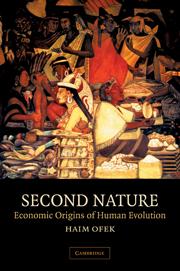Book contents
- Frontmatter
- Contents
- Acknowledgments
- 1 Introduction
- Part 1 Bioeconomics
- 2 Exchange in human and nonhuman societies
- 3 Classical economics and classical Darwinism
- 4 Evolutionary implications of division of labor
- 5 The feeding ecology
- 6 The origins of nepotistic exchange
- 7 Baboon speciation versus human specialization
- Part 2 Paleoeconomics
- References
- Index
4 - Evolutionary implications of division of labor
Published online by Cambridge University Press: 06 July 2010
- Frontmatter
- Contents
- Acknowledgments
- 1 Introduction
- Part 1 Bioeconomics
- 2 Exchange in human and nonhuman societies
- 3 Classical economics and classical Darwinism
- 4 Evolutionary implications of division of labor
- 5 The feeding ecology
- 6 The origins of nepotistic exchange
- 7 Baboon speciation versus human specialization
- Part 2 Paleoeconomics
- References
- Index
Summary
Division of labor can evolve (i.e., be selected for) only if all its structures and partaking entities are properly exposed to natural selection. By implication, division of labor can be anticipated to readily evolve only if it occurs at a level of organization strictly below the unit of selection. For instance, the division of labor among cells and organs of a single healthy organism is possible largely because the unit of selection typically rests at the level of the organism, if not above it. By its very nature, division of labor is an interaction among two or more partly independent entities that have to share, somehow, the costs and benefits of their common endeavor. They need a system of redistribution. This is provided and best regulated by the designated unit of selection on behalf (and from above) all its constituents. For the same reason, division of labor can evolve only with great difficulty at or above the level of organization of the unit of selection. Ordinarily it does not successfully occur at such levels, and those rare instances where it does are invariably associated with evolutionary innovations of great interest. These innovations are the main subject to be discussed in the present chapter.
Some aspects of division of labor are transitory. They may rise in one generation only to fade away in another depending on the changing environment and, in human society, on the rise and fall of contemporaneous technologies (an example is provided by the ever-changing sexual division of labor in human society – to be discussed in a subsequent section).
- Type
- Chapter
- Information
- Second NatureEconomic Origins of Human Evolution, pp. 44 - 61Publisher: Cambridge University PressPrint publication year: 2001

